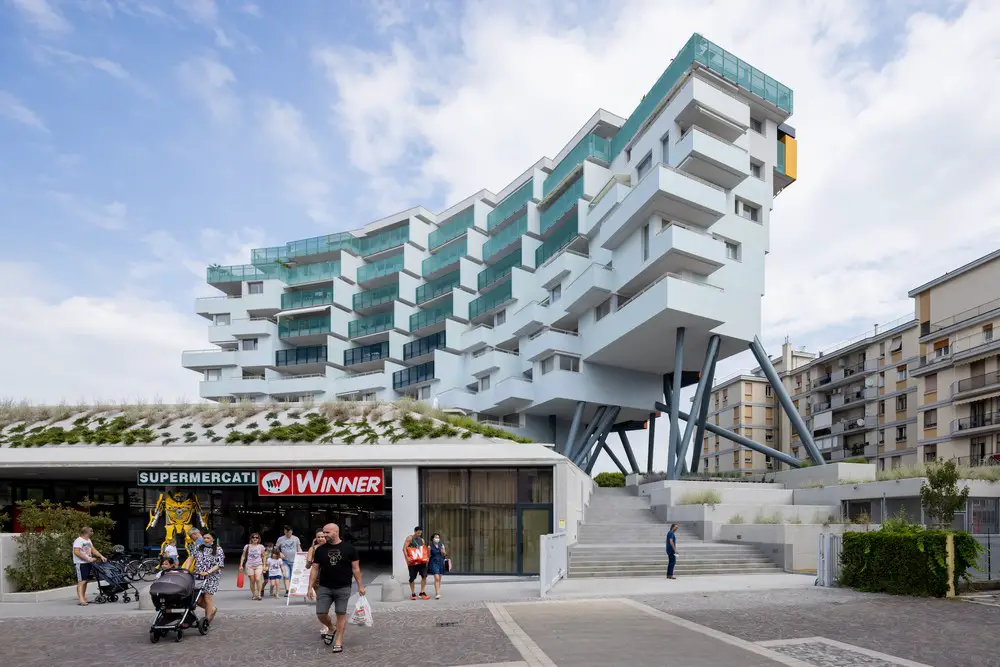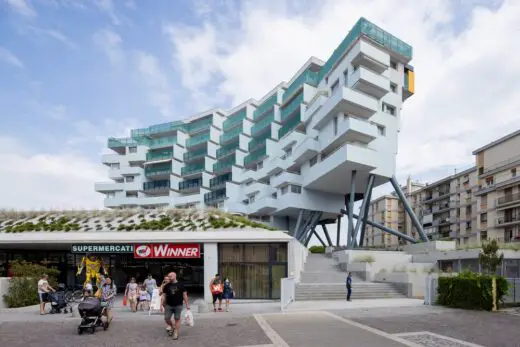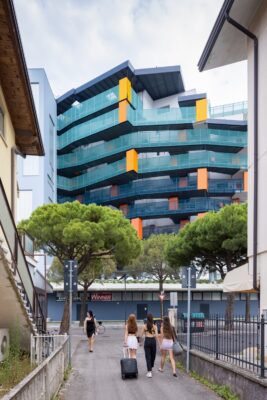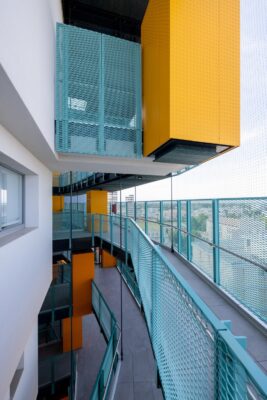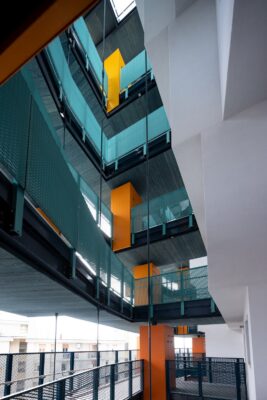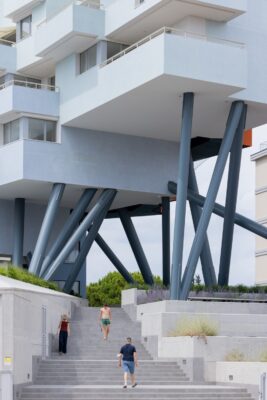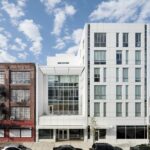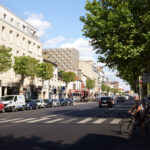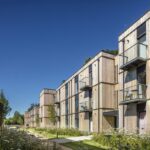The Building Descending the Stairs, Venice, Italy, Housing, Venetian Modern Apartments, Architecture Photos
The Building Descending the Stairs near Venice
7 Apr 2022
Architects: ELASTICOFarm
Location: Lido di Jesolo, Venice, Italy
Photos: Iwan Baan
Le bâtiment descendant l’escalier
The The Building Descending the Stairs project by Stefano Pujatti (ELASTICOFarm) in Lido di Jesolo, a tourist seaside destination close to Venice, Italy, both critiques and reinterprets a functional and spatial program to promote a more intense and lively relationship between the inhabitants and the urban environment.
The residential floors are arranged in the form of an arc above a forest of pillars that raise them above street level, thus creating an open space, intended for meeting and socializing, which ideally extends the public space into the building.
Common and private areas are combined in an elaborate system of balconies that involve all the floors of the new building by ELASTICOFarm. The result is an innovative, unexpected solution in which shape, color and material play an important role in the perception of the new urban organism.
Le bâtiment descendant l’escalier is the residential and commercial building that ELASTICOFarm just completed, together with bplan, in Lido di Jesolo, a tourist seaside destination close to Venice, Italy. The building emerges with strength and determination amid suburban sameness to affirm the need for renewal and redemption from the banal uniformity of the surrounding constructions. At the same time, it establishes an effective relationship between private and shared spaces and the public realm of the city.
Sited just 150 meters from the beach, the building stands out, formally as well as size-wise. Its two programs — commercial at street level and residential in the 8 floors above — are separated by a “ghost” floor that provides an open and partially covered area of approximately 2,000 square meters for amenities. Raised above street noise, it promotes sociability among neighbors and welcomes passersby. This space, which ideally extends the public realm into the building, is characterized by an exuberant structural solution that allows the upper floors to disengage from the urban fabric. A forest of steel columns supports the residential floors which, as if suspended, are arranged in the form of an arc. Conceived as a vineyard that is arranged to enjoy maximum sun exposure, the upper portion of the building accommodates apartments each endowed with large terraces and open views towards the great Venetian lagoon, the Dolomites as a backdrop.
The circulation system for the residences extends the idea that guides the project by offering itself as a device that promotes encounters among the inhabitants. Common and private areas are located on all floors, with balconies that distinguish the north-facing side of the building. An unexpected appearance in which colors and materials play an important role in the perception of the new architectural organism.
ELASTICOFarm, the architecture firm led by Stefano Pujatti, has carried out a series of groundbreaking projects, inventive and brilliantly expressive, in various contexts: from suburban to vast natural settings, in Italy and in Canada. Stefano is one of the most talented and lively Italian architects of his generation. Completed in 2021, Le bâtiment descendant l’escalier is the outcome of research and experimentation.
As Pujatti has put it, “this urban intervention plays the ambiguous role of responding to the needs of investors just as it critiques and revisits the given functional and spatial program. In responding to their demands, in fact, the project explores new possibilities and promotes a different way in which private residences engage with the urban as well as the natural environment and its inhabitants.”
The quality of this project is measured in its ability to exploit the location and the building type to create an architecture in which communal space becomes the protagonist of a brilliant experimentation.
ELASTICOFarm
Jesolo is the Italian seaside town with the largest beach extension. The City is part of a once insular territory which only became a touristic destination in the 1930’s.
Large reclamation works have connected the mainland to those islands where during the centuries small farms and fishermen villages had been built. Today Jesolo is part of a vast territory and finds itself near both Venice and the Dolomites, giving the city a privileged position attracting not only local visitors, but also those from Germany, Austria and many other Northern nations. Jesolo Lido is the most touristic part of this city and extends for almost 15 km along streets which run parallel to the sea. One of these roads, only a block away from the beach, is via Bafile, the main shopping street of the city.
The urban project
The intervention area is located between via Bafile and via Aquileia, just 150 meters from the beach. The area was occupied by a National History Museum. The building itself had little to no value. The urban plan designed by the city foresaw the demolition and relocation of the museum and the construction of a residential and commercial building. The area is surrounded by residential properties with commercial activities on the ground floor dating back to the fifties and sixties with no architectural qualities and uneven in shape, height and finishes. The new building stands out and appears out of scale when compared to its surroundings. However, it still tries to mitigate its presence and avoid impacting as much as possible the views and the lesser qualities of the other buildings. The site, located in the tourist heart of the city, has a clear commercial vocation that the project has attempted to maximize without compromising the residential potential of the area overlooking Piazza Carducci.
This area that links our site to the most active pedestrian street in the city inspired us to create a connection with via Aquileia as well, activating the entire urban block at different levels. Piazza Carducci uses the new building as a background and as a means of connecting with the district to the north.
The functional organization
To make the most of both the commercial and residential potential of the area, we have decided to clearly separate the two parts in the building by interposing a “ghost” floor between them. The roof of the commercial space became a new artificial territory and a stilt structure capable of supporting the eight residential floors rising above it.
The new apartments can therefore enjoy an open and partially covered area of approximately 2.000 square meters for amenities while also being raised above the street noise and organized in a way to promote sociability between the neighbours. This privileged floor can also be crossed on the perimeter by people wishing to reach via Aquileia without going around the building. A large scenographic staircase puts the level of the podium in contact with the piazza and the commercial street. The displacement of the ground floor in section provides a natural connection between street and commercial activities creating a new relationship between building, public space and private common spaces. Thanks to this new “empty” floor, the residential building is able to be developed independently from what is happening at street level.
Conceived as a vineyard that is arranged to enjoy maximum sun exposure, the suspended building takes the form of an arc and organizes the apartments so that, moving back upwards, they are enriched with large terraces and open views towards the sea. In doing so, each unit makes the most of its position and the only qualitative variable is given by the floor level on which the apartment is located. This is a building designed to house holiday homes and, for this reason, designed to give maximum use of its outdoor areas, views, and exposure. For the most part the apartments consist of two bedrooms, a living area and two bathrooms. Only the apartments on the higher floors are larger.
The desire to design scenarios that promote the sharing of spaces within the condominium areas led us to imagine a distribution system for residences that would become the extension of the large podium space. The distribution system is thus conceived as a device that, in addition to serving the living spaces, promotes the meeting between the inhabitants. Common and private areas are arranged along the path defining an open volume connecting on all floors. It is a large empty volume overlooked by the walkways and the rest areas and from which you can see the great Venetian lagoon and the Dolomites as a backdrop. Four are the elements that make up this building: the commercial podium, the “phantom floor”, the terraced residential block and the distribution system that defines an alternative space to the strictly private one. These elements assembled in the project in a not always predictable way produce spatial, morphological and perspective effects capable of surprising even those who live regularly in the building.
The structure
The structure is one of the elements that formally characterizes this intervention. As explained in the previous chapter, this construction is made up of three different elements that then define a fourth element represented by the great void of the “phantom floor”. Each of these parts lives on its own functional and even structural logic.
The commercial floor connected to the basement of the car park is structured on an orthogonal mesh that is denser in the basement and rarefying on the commercial floor to allow maximum flexibility and the best arrangement of the supermarket shelves. Those structural pillars supports the amenity spaces where the relax area, the roof garden, the solarium and a large swimming pool are located. On the other hand, the suspended residential building uses concrete structural partitions which, arranged in a radial pattern, define the individual apartments in a regular way, allowing the best possible use of the internal spaces.
Finally, the walkways are supported by a structural system that uses the supporting walls of the residential block to hang a lighter structure made up of metal beams. Those connected to each other then support the walkways. This part of the structure is stiffened by the weight and by the arrangement of the parapets which also act as wall beams in some areas. These three systems use very different structural logics and, if the balconies and the residential volume manage to complete each other structurally, it is less intuitive to imagine a collaboration between the rarefied orthogonal structure of the commercial part and the radial arrangement of the structure of the residences. The void left by the “phantom floor” allowed us to explore a solution in which a new structural system such as collagen connects the load bearing walls of the suspended block with the concrete pillars of the commercial part. The only apparent randomness of the stilted structure gives life to an organic space that characterizes the covered part of the phantom floor. The exhibit structure provides character to the space. Like a complex organism, the building seeks its own balance and in doing so it expresses that dynamism that the structural part tries to avoid.
The materials
The choice of materials follows the logic of using, reinterpreting and reinventing what exists in the surrounding visual landscape. At the same time, the theme of duration over time and the reaction of materials to the aggressive maritime climate have guided and suggested our choices.
The commercial block that defines the podium by moving the ground floor to a higher level expresses its belonging to the earth through the use of bush-hammered exposed reinforced concrete. This hard concrete block rises from Piazza Carducci, expanding its size through the monumental stairway which uses the same stone material. The body of the residences, suspended from the metal stilts, plays with the light, changing its reflections and colours during the different hours of the day. The walls appear to be white because it is cladded with white mosaic tiles but when the grazing light of sunrise or sunset hits the surfaces the building shines a variety of different colours. This effect of colouring the light (and not the building) was achieved by using stucco of different colours in the joint between the glass tiles. The resistance to the maritime climate of the ceramic and glass mosaic cladding made the use of this material popular during the years of maximum building expansion in Jesolo. Despite the not very valuable examples left in the area, we considered it important to reinterpret this material in order to exploit both its resistance characteristics and the partly unexplored ones of material expressiveness.
The distribution system of the suspended walkways imposes a strong vision of the building for visitors coming from the north. It is an unexpected image, one where colour and matter play an important role in the perception of this new architectural organism. Inspired by the fishermen’s nets of the Venetian lagoon, the system of wire mesh railings uses the colours of green and blue, fading them from the first to the last floors of the building. The small coloured cabins arranged at the entrances to the apartments dot this elevation and in their irregular repetition recall the buoys used to support the fishing nets but also the cabins of the nearby beaches.
The vegetation that occupies a large part of the surface of the “phantom floor” acts as a filter between public and private spaces, but also contributes to designing the covered and uncovered areas of the podium. The covered condominium area on the common floor will thus become a place of refreshment and coolness during the hottest and sunniest hours, the water level of the swimming pool and the wooden flooring of the solarium will complete this landscape designed for well-being.
We tackled the issue of building holiday apartments thinking that we owe much of the ruin of our seascapes to this type of building, but at the same time believing that our country’s tourist vocation should be considered a great opportunity also for architectural research.
This project plays the ambiguous role of responding to the needs of investors just as it critiques and revisits the given functional and spatial program. In responding to their demands, in fact, the project explores new possibilities and promotes a different way in which private residences engage with the urban as well as the natural environment and its inhabitants.
Berggruen Institute – Building Information
Name of the project: Le bâtiment descendant l’escalier
Location: Lido di Jesolo, Venice, Italy
Design: ELASTICOFarm – www.elasticofarm.com with bplan studio
Design team
Stefano Pujatti, Alberto Del Maschio, Marco Bottosso, Valeria Brero, Daniele Almondo, Serena Nano, Andrea Rosada, Boris Cibin
Client: NUMERIA SGR Spa
Structural project: SAICO Ingegneria Srl
Mehanical systems project: Studio Termotecnico Gabrielli
Builder: C.E.V. Spa
Metal Carpentry: GR strutture Srl
Schedule
Design start: April 2015
Start of construction: September 2018
End of construction: December 2020
Completion: March 2021
Data
lot area: 4.500 square meters
residential area: 3.380 square meters
commercial area: 1.600 square meters
amenities area: 2.000 square meters
public paths: 480 square meters
number of dwellings: 47
Suppliers
Residential units window frames (windows and doors): Falegnameria Schiavon Domenico, Trevignano (TV)
Commercial units window frames (supermarket windows, entrances and stair tower): IALC Serramenti, Romano d’Ezzelino (VI)
Flooring (balconies and condominium paving) and Mosaic cladding: Marazzi Group
Metal carpentry structures and Metal sheet railings: Gr Strutture, Vigodarzere (PD)
Heating and sanitary systems: Paolin Impianti, Padova
Electrical systems: Cable Impianti, Treviso
Landscaping: Benetazzo Spazioverde, Favaro Veneto (VE)
Photographs: Iwan Baan – www.iwan.com
The Building Descending the Stairs, Venice images / information received 070422
Location: Venezia, Italia
Venice Architecture
Venice Architecture Designs – chronological list
Venice Architecture Tours by e-architect
Venice Architecture News – selection below:
Enel Power Plant Venice Building
Design: Frigerio Design Group
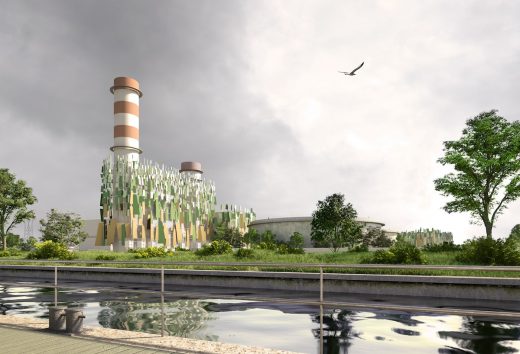
render courtesy of architects office
Enel Power Plant Venice Building
Vimar logistics and production hub, Marostica, province of Vicenza, Veneto, northern Italy
Design: Atelier(s) Alfonso Femia
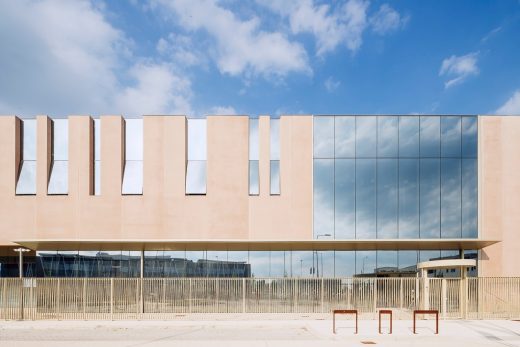
photo © Stefano Anzini
Vimar logistics and production hub
La Biennale di Venezia 2021
Home Ground, Alison Brooks Architects
The Majlis at San Giorgio Maggiore
Pavilion of Finland Venice Biennale 2021
Young Talent Architecture Award 2020
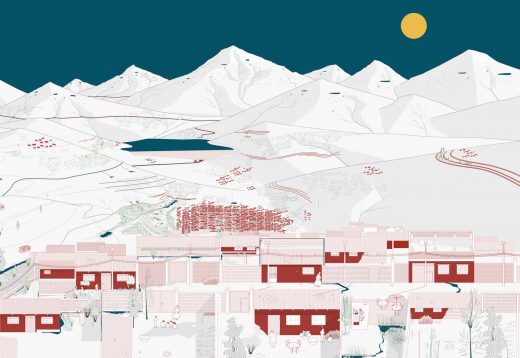
picture Courtesy Fundació Mies van der Rohe
Young Talent Architecture Award 2020
Comments / photos for the The Building Descending the Stairs, Venice page welcome

